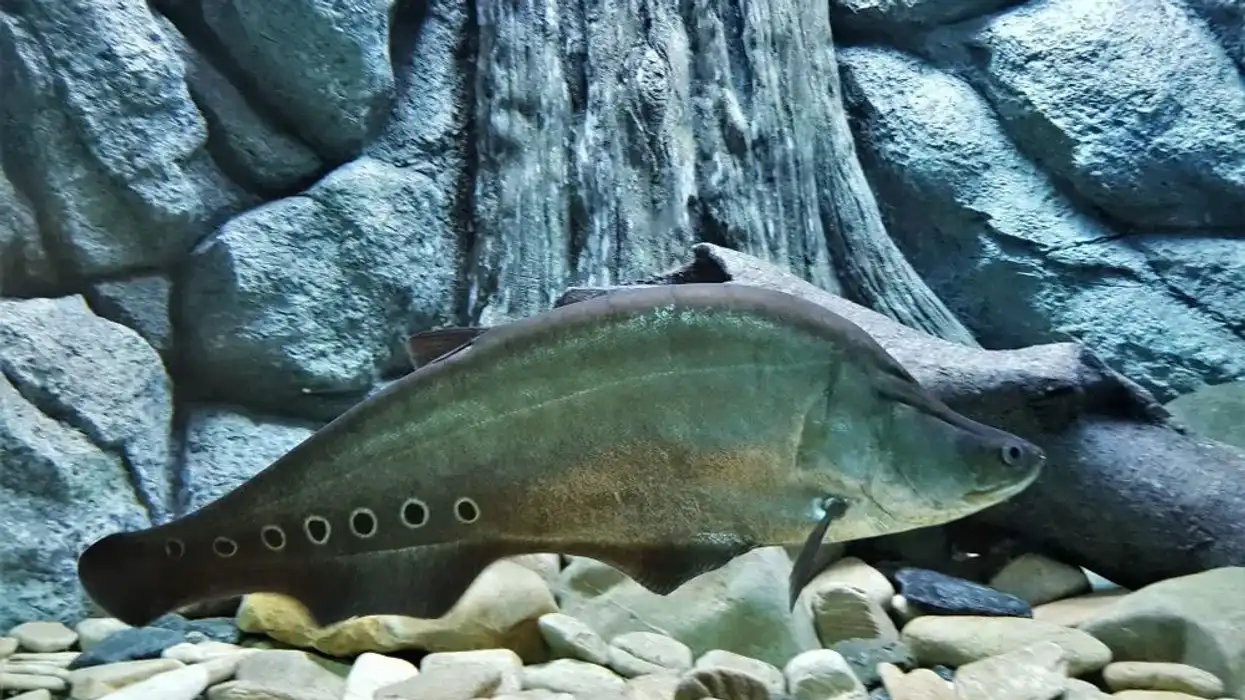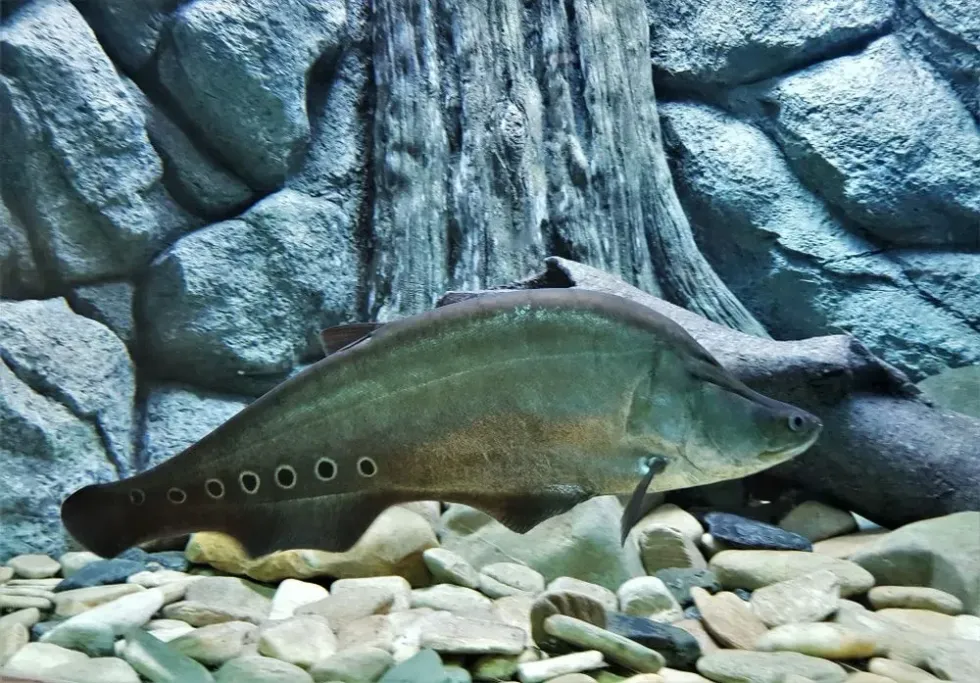The Chitala genus is known to have six members included. The six members are Chitala chitala, Chitala ornata, Chitala blanci, Chitala hypselonotus, Chitala borneensis, and Chitala lopis.
Out of these six notopterus members, Chitala lopis is currently extinct and has no existence on the planet. They are spread through the rivers and the swamps of South Asia.
A few groups can also be spotted in the river basin of Phraya. The native areas of these countries have recently experienced the habitat of this species. These species can be seen around the low Riverland of the Philippines, Indonesia, Singapore, and Sri Lanka.
Bangladesh in the southeastern part of Asia is known to cultivate these fish for commercial purposes. The fish are known to be spread to the freshwater rivers in Florida.
The Broward county basin in Florida is home to these Chitala genus species as well. These notopterus creatures can be spotted in an aquarium as well.
If you like reading this, you might want to read about piranha fish facts and round goby facts too.
Chitala Interesting Facts
What type of animal is a chitala?
A clown knifefish or Chitala ornata is a fish. It is considered as the old world freshwater fish (family notopteridae) belonging to the Osteoglossiformes order.
What class of animal does a chitala belong to?
These ray-finned fishes belong to the Actinopterygii class of animals. They are one of the six members of the Chitala genus species in the Chordata phylum.
How many chitala are there in the world?
The clown knifefish or the ray-finned fishes are listed under the Least Concern category by the International Union for Conservation of Nature (IUCN). Although these fishes are Least Concern at the moment, the exact distribution and population of this fish species are not known to the researchers as of now.
Where does a chitala live?
The clown knifefish of the Osteoglossiformes order, family Actinopterygii is a fish species of the south Asian waterbodies mostly. These fish are found in abundance near the freshwater rivers of Cambodia and Laos. This range extends up to the rivers of Thailand and Vietnam. In these countries, the fish are found in the basins like Mekong, Chao, and Mekong.
What is a chitala's habitat?
The major distribution of this fish is found to be near any freshwater river. A few fish can be seen surviving along the lowlands of the river. This lowland is either filled with a rock base or with a sand base. The fishes are most comfortable living around the bottom or middle length of the river.
Who does a chitala live with?
Chitala species are mostly kept in singles in an aquarium. Their probable partners in the aquarium are usually greater than them by size who would not be a threat to their existence.
How long does a chitala live?
The average lifespan of a clown featherback fish is known to be around 10 years on average. The average lifespan of the rest of the five members is not known as of now.
How do they reproduce?
Chitala breeding is mostly spotted in freshwater rivers or swamps. On rare occasions, it can be seen in ponds as well. The fish lay eggs in reservoirs during the months of June to July.
During this time the commercial price of the fish rises as well. In order to keep the egg, they dig the soil. When the soil is too rocky, they lay eggs on the aquatic plants as well.
What is their conservation status?
The six members of the Chitala genus species vary from each other in terms of their conservation status. According to the International Union for Conservation of Nature (IUCN), Chitala chitala and chitala blanci belong to the Least Concern category with a decreasing trend in their population.
Chitala ornata, Chitala borneensis, and Chitala hypselonotus and listed as Near Threatened species whereas Chitala lopis is considered to be Extinct by scientists.
Chitala Fun Facts
What does a chitala look like?
A fish of the Osteoglossiformes order (family Notopteridae), these notopterus species are elongated in length. They have a bony structure with few distinctive ocellated spots on them. The scales are mostly silvery with a narrow dorsal fin at the back. Due to this narrow fin, the fish gets looks like a sharp knife.
How cute are they?
Unlike yellow tang, these species can not be termed cute accurately. The knife-shaped bony structure and the ocellated spots give them a terrifying look.
How do they communicate?
Being a creature of the lower range of water, the communication process of the notopterus fish is not known to the researchers as of now.
How big is a chitala?
A chitala species could be pretty big in size with an average weight of around 11 lb (4.9 kg). They have an average length of around 22-39.3 in (55.8-99.8 cm).
Although they are pretty large, these species are almost half the size of a rohu fish in length. The average length of a rohu fish is around 78.7 in (199.8 cm).
How fast can a chitala swim?
Although this fish could be pretty predatory in nature, the exact speed of the fish is not known yet.
How much does a chitala weigh?
An average fish has a weight of around 11 lb (4.9 kg). They are way lighter than a humphead wrasse.
What are the male and female names of the species?
There is no specific name assigned to the male and the female members of the species. These ray-finned fishes are usually referred to as the sex that the individuals belong to.
What would you call a baby chitala?
A baby chitala is usually referred to as a juvenile or as a fry.
What do they eat?
These species are carnivores in nature. They have a range in terms of food which includes small fish and worms. Fish like Chitala chitala feed on the feeder fish and insects whereas many others are seen to feed on the ghost shrimp and blackworms found in the swamps or rivers.
Are they poisonous?
There has been no information regarding the species being poisonous to animals or to humans.
Would they make a good pet?
These species are seen to be kept in aquariums on a large scale as a pet. They are mostly kept in singles and have turned out to be good pets to humans.
Did you know...
When kept in a tank or aquarium the species require a minimum amount of 132.1 gal (500 l) of water to survive and thrive.
The clown knifefish is known to attain sexual maturity by the time they have an average age of around three years.
Why is it called featherback/knife fish?
The dorsal fin present on top of the body of the fish is narrow and thin. This thin fin gives them a slender feather-like look. Hence these fish is referred to as featherback fish.
Can we eat chitala fish?
Yes, chitala can be consumed. This species is considered to be a celebrated delicacy in West Bengal, Assam, and Bangladesh.
Here at Kidadl, we have carefully created lots of interesting family-friendly animal facts for everyone to discover! For more relatable content, check out these shark facts and clownfish facts for kids pages.
You can even occupy yourself at home by coloring in one of our free printable fish outline coloring pages.
Second image by Mistvan.










